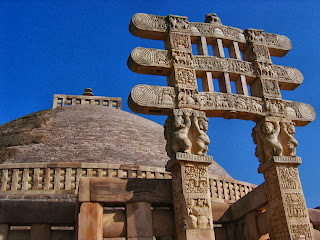SANCHI
Emperor
Asoka (273-236 B.C.) built stupas in
Buddha's honour at many places in India. Stupas at Sanchi are the most
magnificent
structures of ancient India. UNESCO has included them as one of the
heritage sites of the world. Stupas are large hemispherical domes,
containing a central chamber, in which the relics of the Buddha were
placed. Sanchi stupas trace the development of the Buddhist
architecture and sculpture at the same location beginning from
the 3rd century B.C. to the 12th century A.D.
Asoka when he was a governor
married Devi, the daughter of a respected citizen of Vidisha, a town 10 km from
the Sanchi hill. Prince Mahendra visited Sanchi with his mother before
leaving for the island of Lanka for taking Buddhism there. Emperor Asoka had
put up at Sanchi a pillar edict and a stupa containing relics of the Buddha.
Addition of new stupas and expressions in stone of legends around
the life of the Buddha and the monastic activities at the Sanchi hill
continued under several dynasties for over fifteen hundred years. Also, the
Brahmi script could be deciphered from the similarities in inscriptions carved
at different places in the main stupa.
Sanchi
stupas are noteworthy for their gateways as they contain ornamented
depiction of incidents from the life of the Buddha and his previous
incarnations as Bodhisattvas described in Jataka tales. Sculptors
belonging to different
times tried to depict the same story by repeating figures. The Buddha
has been
shown symbolically in the form of tree or through other inanimate
figures. One
of the sects of Buddhism opposed depiction of the Buddha by a human
figure.
The top of the
Asoka pillar, which comprises of four lions, has been kept in the museum
maintained by the Department of Archaeology. The size and the weight of the
pillar point to advanced construction technology that was existent at the time of Asoka.
It must have been an incredible feat of engineering to bring the
stone for carving the pillar from the mine to Sanchi and installing
it up the hill.






.JPG)


NICE
ReplyDelete